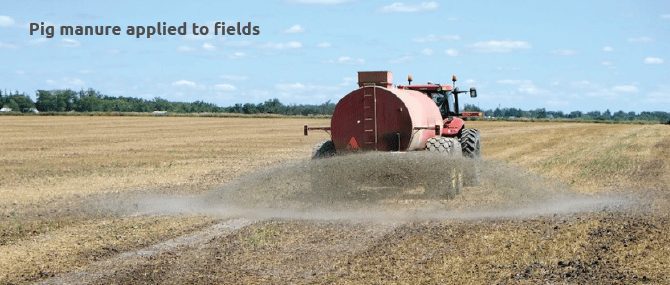Pig manure is not a waste product; it is a valuable source of plant nutrients with the added benefit of improving soil quality. Applying manure to croplands is the most obvious method of replacing plant nutrients. Pig manure contains all 13 essential nutrients required by plants, including nitrogen (N), phosphorus (P) and potassium (K), as well as a large proportion of organic matter, which provides multiple benefits including:
- Improves soil texture and quality
- Improves water uptake and water holding capacity
- Encourages soil micro flora and biodiversity
- Saves costs from purchasing commercial fertilisers
- Increases economic returns
- Increases crop yield and production
- Improves plant nutrient concentration
- Ensures sustainable production from land
- Increases leave density, plant height and stem diameter
- Abundantly available
- Organic matter provides pH buffer for soil.
However, mismanagement of pig manure as organic fertiliser may have some disadvantages, including risk of over application leading to nutrient leaching and runoff into ground water, toxicities and growth suppression. Other obstacles include odour, bulkiness, difficult to handle, transport etc.
Manure value depends on four factors, including nutrient content, nutrient availability, method and rate of application and the current value of commercial fertilisers.
Successfully using manure as a fertiliser requires assessing the available nutrients in manure, calculating the appropriate application rate to provide the needed nutrients to the crop and applying manure uniformly across the field.
Knowledge of the amount of manure and plant nutrients produced on a pig farm is the first step in proper manure handling, treatment and utilisation. Manure composition will vary with digestibility of the ration, animal age, amount of feed, water wasted and amount of water used to remove manure from buildings etc. Application rate per hectare typically depends on the nitrogen requirement of the plants. Manure differs from most commercial fertilisers in that it typically includes a mix of organic nitrogen compounds that require conversion to inorganic nitrogen by microbes before it becomes available to the plant, therefore providing slow release of nutrients. Not all nitrogen in manure is available to the plant, as nitrogen can be present in manure as ammonium-N, organic-N and nitrate-N. A large proportion in liquid swine manure is in ammonium (NH4+) form, which can interchange rapidly to ammonia (NH3). Ammonia is a gas and can be readily lost in the air through volatilisation, therefore compromising manure nutrient content.
If manure is simply applied to the surface of the soil, then large amounts of ammonia nitrogen can be lost in the atmosphere. It is therefore recommended that manure should be incorporated into soil by a tillage operation or direct injection into the soil to reduce ammonium losses.
Incorporating a Manure Management Plan (MMP) can assist in applying nutrients more accurately, therefore reducing nutrient losses from excess nutrient application.
Steps for a successful MMP:
Step 1: Test the soil
Collect information on field slope, soil type and soil test results
Types of crops and rotation plan for each field.
Step 2: Test the manure
Determine amount of manure expected per year
Rule of thumb: It is expected that a
50 kg pig will produce 1 000kg manure per year.
Take manure samples for analyses of nutrients (collect samples annually)
Step3: Establish a realistic target yield for your region and production capacity of the soil.
Step 4: Calculate manure application rate
Plan how much manure should be applied to meet crop and soil requirements.
Step 5: Calibrate equipment to deliver target rate.
Step 6: Keep records
Manure should be spread in fields during spring when plant uptake of nutrients is efficient. Manure should only be applied according to the needs of the crop and soil to ensure profitable crop cultivation. Also avoid applying manure to wet soils to reduce compaction, runoff and leaching. Pig manure NPK: 0.8:0.7:0.5
The aim of fertilisation is to feed the soil in order to feed the plant by filling nutrient gaps rather than simply increasing N and P.
The South African Pork Producers’ Organisation (SAPPO) coordinates industry interventions and collaboratively manages risks in the value chain to enable the sustainability and profitability of pork producers in South Africa.









